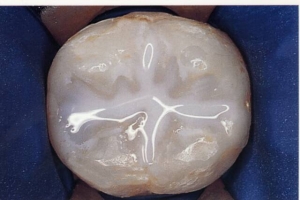Decay on back teeth, premolars, and molars usually begins in the grooves and fissures that normally exist on the biting surfaces of the back teeth. Dental sealants, available since the 1960’s, are clear plastic coatings that can be placed on the biting and grinding surfaces of posterior teeth. These sealants prevent the formation of decay on the treated surfaces. Sealants can even be placed on teeth with small areas of decay known as incipient carious lesions. The sealants will stop the customary progress of tooth destruction. It can remain on the tooth from 3 to more than 20 years, depending on the tooth, type of sealant used, and the eating habits of the patient. It can only be placed on teeth that have not been previously restored.
The sealant is placed on the tooth through a chemical/mechanical bonding procedure. There is no drilling or local anesthesia required for the sealant application procedure. It is entirely painless.
It is clear that if the initial decay is prevented from beginning or is small enough to use a sealant, there is a great savings in time, money, discomfort, and tooth structure. Decayed teeth must have the decay removed by drilling, then they must be filled. This drill and fill may have to be done several times over the patient’s lifetime as the filling ages and needs replacement. It is suggested that patients who have teeth that can be successfully protected with a sealant material to consider having this procedure performed as soon as possible.
Sealants and Prevention
It is especially recommended that children have the sealant applied to their teeth as soon as the teeth break through the gum and the biting surfaces of the teeth are no longer covered with gum tissue. If the teeth cannot be totally isolated from the moisture in the mouth during the bonding process, it is likely that the sealant will not remain on the tooth for as long a period of time as expected. The sealant is most often applied to permanent teeth, but sometimes a situation arises in which it would be beneficial to have the sealant applied to a primary tooth.
A study completed in 1991 found that one application of sealant reduced biting surface decay 52% over a 15-year period. Another study, completed in 1990, showed that decay on biting surfaces could be reduced 95% over 10 years if 2% to 4% of sealants were routinely repaired each year. Sealants are expected to last many years. Replacing or repairing sealants, as needed, on an ongoing basis will give the best protection.
A sealant is not meant as a substitute for proper brushing and flossing habits. The effectiveness of the sealant is reduced if oral self-care is neglected. Also, cavities can still form on untreated surfaces. Therefore, a topical fluoride treatment remains an essential and necessary preventative aid.
At Star of Texas Dental Assisting School, we believe in the importance of educating our students through classroom and hands-on learning. Our dental assisting program is taught by experienced instructors who have been in the dental industry for several years.
Please give us a call if you are interested in signing up for our dental assisting school to get certified as a dental assistant in just 12 weeks!
Image from: http://www.childrensdentalhealth.com/dental-procedures/dental-sealants/


